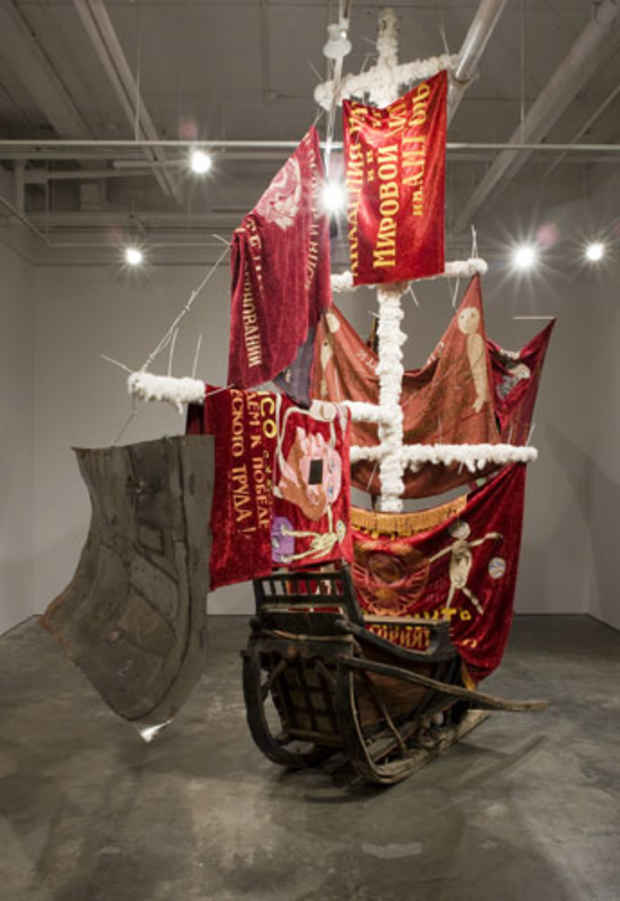Afrika (Sergei Bugaev) "Good Ballerina Is Always Right"
I-20 Gallery

This event has ended.
For his fourth exhibition at I-20, Good Ballerina Is Always Right, the Russian artist Afrika (Sergei Bugaev) presents a new installation. A ship’s mast bearing three sails crowns a stylish two-seat wooden sleigh produced at the turn of the last century for a Siberian noble. One glance is not enough to realize the complex symbolic nature of the sails. They are former Soviet flags of various types, but a closer examination reveals that they have some strange, extraneous images, phrases and misspelled words. Several more flags of this same type are represented on the gallery walls. The flagged mast bears another strange artifact that seemingly hampers the sleigh’s locomotion: a large sheet of metal is hanging from a rod attached perpendicularly to the mast.
This installation is genealogically related to two earlier performances by the artist. The first one, which took place in 1987, was entitled Donald Destruction. During this performance, Sergei Bugaev penetrated the giant monument Worker and Kolkhoz Woman (sculptor Vera Mukhina, 1937). This monument produced as a centerpiece of the Soviet pavilion at the 1937 International Exhibition in Paris was later installed in Moscow at the All-Soviet Exhibition Center and gradually became a symbol of Soviet might. Bugaev succeeded in dismantling a steel door that was located in the sacral spot of this feminine body and later used it as a ready-made piece entitled Pussy in Donald Destruction. It is this object that we see in front of the sleigh.
The second performance formative of this installation took place in 1995 at a psychiatric clinic located on the Crimean peninsula of the Black Sea. In the course of this project that was later called Krimania, the artist spent a month with the clinic’s chronic inmates preparing an exhibition. The theoretical background of the performance referred to Roman Jacobson’s study of aphasia (or loss of comprehension of language). The artist was resolved to face his own inability to express his emotive inner contents in the form of exhibitions and art representation in the context of communication with aphasic people, who are insensitive to the hierarchy of linguistic elements. His communication with the clinic inmates was focused on the then painful topic of the collapse of the Soviet Union, which made flags – the ideological essentials of Soviet life – a natural topic of discussion. During the performance, patients helped Bugaev produce a series of flags with some aphasic incoherence of post-Soviet traumatized consciousness. In the present exhibition, each flag is coupled with a photograph of a patient whose speech practice brought about extraneous elements incorporated in the flag. From the artist’s perspective, the Krimania performance confirmed some of his own ideas of the notion of obsessional representation. (Olga Serebryanaya contributed to this text for the press release.)
Media
Schedule
from March 28, 2008 to May 03, 2008
Opening Reception: March 28, 6-8pm